Systematic Literature Review Predictive Maintenance Solutions for SMEs from the Last Decade
Abstract
:1. Introduction
- Has fewer than 250 employees
- Its annual turnover is less than EUR 50 million or its annual balance sheet is less than EUR 43 million total.
2. Research Methodology
2.1. Scope and Objective
2.2. Research Questions (RQs)
- Q1.
- What are the most significant expectations and concerns of stakeholders in SMEs in regard to implementing PdM?
- Q2.
- What are the most important challenges SMEs are faced with regarding predictive maintenance?
- Q3.
- What equipment, facilities, and resources are required for PdM techniques in small- and medium-sized companies?
- Q4.
- How have recent studies provided an appropriate solution to implement predictive maintenance by considering the previous questions?
2.3. Search Strategy and Database
- IEEE Xplore Digital Library (www.ieeexplore.ieee.org, accessed on 28 April 2021)
- Springer (www.springerlink.com, accessed on 28 April 2021)
3. Early Results of SLR and RQs
3.1. Article Extraction Process
3.2. Stakeholder Expectations
3.3. SME Challenges
3.4. Requirement
3.5. Summary of Studies and RQ Answers
- Data collection: To obtain relevant data and manage its content. Data can be collected from a variety of sources, including sensors, RFID tags, people, and so on.
- Data transfer: The collected data need to be transferred without affecting their content. Data are transferred from the source to the data management system.
- Data integration: Combining data from different sources in a data warehouse using methods that ensure its quality.
- Data analysis: Data analysis and extract information and knowledge to support decision making by managers.
- Visualization: By visualizing the information required by the users or decision makers. Visualization can be statistical or reporting.
4. Discussion
5. Conclusions
6. Future Work
Author Contributions
Funding
Institutional Review Board Statement
Informed Consent Statement
Data Availability Statement
Acknowledgments
Conflicts of Interest
References
- Pintelon, L.; Parodi-Herz, A. Complex System Maintenance Handbook; Springer: Berlin, Germany, 2008. [Google Scholar] [CrossRef]
- Al-Turki, U.M.; Ayar, T.; Yilbas, B.S.; Sahin, A.Z. Integrated Maintenance Planning in Manufacturing Systems; SpringerBriefs in Applied Sciences and Technology no. 9783319062891; Springer: Berlin, Germany, 2014; pp. i–iv. [Google Scholar] [CrossRef]
- Susto, G.A.; Pampuri, S.; Schirru, A.; Beghi, A. Optimal Tuning of Epitaxy Pyrometers a Predictive Maintenance System for Silicon. In Proceedings of the 2012 SEMI Advanced Semiconductor Manufacturing Conference, Saratoga Springs, NY, USA, 15–17 May 2012; pp. 294–299. [Google Scholar]
- Susto, G.A.; Beghi, A.; De Luca, C. A Predictive Maintenance System for Epitaxy Processes Based on Filtering and Prediction Techniques. IEEE Trans. Semicond. Manuf. 2012, 25, 638–649. [Google Scholar] [CrossRef]
- Wang, K.-S.; Li, Z.; Braaten, J.; Yu, Q. Interpretation and compensation of backlash error data in machine centers for intelligent predictive maintenance using ANNs. Adv. Manuf. 2015, 3, 97–104. [Google Scholar] [CrossRef]
- Kumar, A.; Chinnam, R.B.; Tseng, F. An HMM and polynomial regression based approach for remaining useful life and health state estimation of cutting tools. Comput. Ind. Eng. 2019, 128, 1008–1014. [Google Scholar] [CrossRef]
- European Commission. User Guide to the SME Definition; no. 410; European Union: Brussels, Belgium, 2016. [Google Scholar]
- Baglee, D.; Knowles, M. Maintenance strategy development within SMEs: The development of an integrated approach. Control Cybern. 2010, 39, 275–303. [Google Scholar] [CrossRef]
- Matt, D.T.; Modrák, V.; Zsifkovits, H. Industry 4.0 for SMEs: Challenges, Opportunities and Requirements; Springer International Publishing: Cham, Switzerland, 2020. [Google Scholar]
- Sassanelli, C.; Terzi, S.; Panetto, H.; Doumeingts, G. Digital Innovation Hubs supporting SMEs digital transformation. In Proceedings of the 27th ICE/IEEE International Technology Management Conference, Cardiff, UK, 21–23 June 2021. [Google Scholar]
- Sassanelli, C.; Rossi, M.; Terzi, S. Evaluating the smart maturity of manufacturing companies along the product development process to set a PLM project roadmap. Int. J. Prod. Lifecycle Manag. 2020, 12, 185. [Google Scholar] [CrossRef]
- Jatana, N.; Suri, B.; Rani, S. Systematic Literature Review on Search based mutation testing. E-Informatica Softw. Eng. J. 2017, 11, 59–76. [Google Scholar] [CrossRef]
- Chompunuch, S. Exploring and Modeling the Concept of Team Creativity. In Proceedings of the AIMS GT Innovation, Grenoble, France, 17–18 October 2019; pp. 1–28. [Google Scholar]
- Budgen, D.; Brereton, P. Performing systematic literature reviews in software engineering. In ICSE ’06, Proceedings of the 28th international Conference on Software Engineering, Shanghai, China, 20–28 May 2006; Association for Computing Machinery: New York, NY, USA. [CrossRef]
- Smart, P.; Hemel, S.; Lettice, F.; Adams, R.; Evans, S. Pre-paradigmatic status of industrial sustainability: A systematic review. Int. J. Oper. Prod. Manag. 2017, 37, 1425–1450. [Google Scholar] [CrossRef] [Green Version]
- Denyer, D.; Tranfield, D. Producing a systematic review. In The SAGE Handbook of Organizational Research Methods; Buchanan, D.A., Bryman, A., Eds.; SAGE Publishing: Thousand Oaks, CA, USA, 2009; pp. 671–689. Available online: https://www.mendeley.com/catalogue/0ff0533c-01f2-338e-a1a9-6f60a28fa801/?utm_source=desktop&utm_medium=1.19.4&utm_campaign=open_catalog&userDocumentId=%7B8b821bd1-4e6e-4cce-8efd-130b29a0bf5b%7D (accessed on 15 April 2021).
- Li, B.-R.; Wang, Y.; Dai, G.-H.; Wang, K.-S. Framework and case study of cognitive maintenance in Industry 4.0. Front. Inf. Technol. Electron. Eng. 2019, 20, 1493–1504. [Google Scholar] [CrossRef]
- Selvaraj, H.; Zydek, D.; Chmaj, G. Virtual Enterprise Process Monitoring an Approach. In Advances in Intelligent Systems and Computing; Springer: Berlin, Germany, 2015; Volume 366, p. V. [Google Scholar] [CrossRef] [Green Version]
- Nag, B.; De, D. The Indian automobile industry: Technology enablers preparing for the future. In New Frontiers of the Automobile Industry; Palgrave Macmillan: Cham, Switzerland, 2020; pp. 301–321. [Google Scholar] [CrossRef]
- Sezer, E.; Romero, D.; Guedea, F.; MacChi, M.; Emmanouilidis, C. An industry 4.0-enabled low cost pre-dictive maintenance approach for SMEs: A use case applied to a CNC Turning Centre. In Proceedings of the 2018 IEEE International Conference on Engineering, Technology and Innovation (ICE/ITMC), Stuttgart, Germany, 17–20 June 2018; pp. 1–8. [Google Scholar]
- Jerrentrup, R. Digital Transformation in SMEs—Lean Management + Industry 4.0; Springer Fachmedien: Wiesbaden, Germany, 2020. [Google Scholar]
- Hoffmann, M.A.; Lasch, R. Roadmap for a Successful Implementation of a Predictive Maintenance Strategy; Springer International Publishing: Cham, Switzerland, 2020. [Google Scholar]
- Adu-Amankwa, K.; Attia, A.K.; Janardhanan, M.N.; Patel, I. A predictive maintenance cost model for CNC SMEs in the era of industry 4.0. Int. J. Adv. Manuf. Technol. 2019, 104, 3567–3587. [Google Scholar] [CrossRef]
- Dobrotvorskiy, Y.; Basova, S.; Dobrovolska, L.; Sokol, Y.; Kazantsev, N. Big Challenges of Small Manufacturing Enterprises in Industry 4.0; Springer International Publishing: Cham, Switzerland, 2020; Volume 1. [Google Scholar]
- Campos, J.; Jantunen, E.; Baglee, D.; Gilabert, E.; Fumagalli, L.; Emmanouilidis, C. The use of mobile tech-nologies and their economic benefits in maintenance. In Proceedings of the 10th World Congress on Engineering Asset Management (WCEAM 2015), Tampere, Finland, 28–30 September 2015; Lecture Notes in Mechanical Engineering; Springer: Berlin, Germany, 2016; pp. 113–119. [Google Scholar] [CrossRef]
- Xu, X. Combination Prediction Method of Power Transformers Based on Feature Gas Arrangement Diagram and Grey Model. In Proceedings of the 2018 IEEE Conference on Electrical Insulation and Dielectric Phenomena (CEIDP), Cancun, Mexico, 21–24 October 2018; pp. 406–409. [Google Scholar] [CrossRef]
- Kiangala, S.; Wang, Z. Initiating predictive maintenance for a conveyor motor in a bottling plant using industry 4.0 concepts. Int. J. Adv. Manuf. Technol. 2018, 97, 3251–3271. [Google Scholar] [CrossRef]
- Baurina, S.B. Smart Industry: Technology for the Future. In Proceedings of the 2020 International Multi-Conference on Industrial Engineering and Modern Technologies (FarEastCon), Vladivostok, Russia, 6–9 October 2020; pp. 22–25. [Google Scholar] [CrossRef]
- Gergin, Z.; Fadime, Ü. Proceedings of the International Symposium for Production Research 2018; Springer: Berlin, Germany, 2019; Volume 1, pp. 426–437. [Google Scholar] [CrossRef]
- Gergin, Z.; İlhan, D.A.; Üney-Yüksektepe, F.; Gençyılmaz, M.G.; Dündar, U.; Çavdarlı, A.İ. Comparative analysis of the most industrialized cities in Turkey from the perspective of Industry 4.0. In Lecture Notes in Mechanical Engineering; Springer: Berlin, Germany, 2020; Volume 1, pp. 263–277. [Google Scholar] [CrossRef]
- Shiling, Z.; Jianchao, W. Time Series Prediction and Pattern Recognition of Fault Decomposition Gas for High Voltage Composite Electrical Appliances Based on Grey System OBGM (1,N) Model. IEEE Conf. Proc. 2019, 2019, 943–947. [Google Scholar]
- Gualtieri, L.; Palomba, I.; Wehrle, E.J.; Vidoni, R. The Opportunities and Challenges of SME Manufacturing Automation: Safety and Ergonomics in Human–Robot Collaboration. In BT—Industry 4.0 for SMEs: Challenges, Opportunities and Requirements; Palgrave Macmillan: London, UK, 2020. [Google Scholar] [CrossRef] [Green Version]
- Jantunen, E.; Emmanouilidis, C.; Arnaiz, A.; Gilabert, E. Economical and technological prospects for e-maintenance. Int. J. Syst. Assur. Eng. Manag. 2010, 1, 201–209. [Google Scholar] [CrossRef]
- Majstorović, V.D.; Mitrović, R.M.; Mišković, Ž.Z. Assessing industry 4.0 readiness in manufacturing companies from Serbia. In Lecture Notes in Mechanical Engineering; Springer: Berlin, Germany, 2020; pp. 69–79. [Google Scholar] [CrossRef]
- Xiong, S.; Liu, Y.; Fang, J.; Dai, J.; Luo, L.; Jiang, X. Incipient Fault Identification in Power Distribution Systems via Human-Level Concept Learning. IEEE Trans. Smart Grid 2020, 11, 5239–5248. [Google Scholar] [CrossRef]
- Starr, A.; Al-Najjar, B.; Holmberg, K.; Jantunen, E.; Bellew, J.; Albarbar, A. Maintenance today and future trends. In E-Maintenance; Springer: Berlin, Germany, 2010; pp. 5–37. [Google Scholar] [CrossRef]
- Thalmann, S.; Schäper, S. Localizing knowledge in networks of SMEs—Implication of proximities on the IT support. In Knowledge Management in Digital Change; Springer: Berlin, Germany, 2018; pp. 189–206. [Google Scholar] [CrossRef]
- Hern, E.; Rodr, S.; Mart, T.S.; Gonz, A. Machine Learning Predictive Model; Springer: Berlin, Germany, 2015; Volume 1, pp. 501–510. [Google Scholar] [CrossRef]
- Heinis, T.B.; Hilario, J.; Meboldt, M. Empirical study on innovation motivators and inhibitors of Internet of Things applications for industrial manufacturing enterprises. J. Innov. Entrep. 2018, 7, 10. [Google Scholar] [CrossRef] [Green Version]
- Kordon, A.K. Business problems dependent on data. In Applying Data Science; Springer: Berlin, Germany, 2020; pp. 39–67. [Google Scholar] [CrossRef]
- Jantunen, E.; Baglee, D.; Campos, D.; Sharma, P. Digitalisation of Maintenance. In Proceedings of the 2nd International Conference on System Reliability and Safety (ICSRS), Milan, Italy, 20–22 December 2017; pp. 343–347. [Google Scholar]
- Wang, X.; Gao, L. 5G Communication Technology in Industry 4.0. In When 5G Meets Industry; Springer: Berlin, Germany, 2020; pp. 75–96. [Google Scholar] [CrossRef]
- Genennig, S.M. Realizing Digitization-Enabled Innovation; Springer Gabler: Wiesbaden, Germany, 2020. [Google Scholar]
- Olanrewaju, A.L.; Abdul-Aziz, A.R. Building Maintenance Processes and Practices: The Case of a Fast Developing Country; Springer: Berlin, Germany, 2015. [Google Scholar]
- Hasselbring, W.; Henning, S.; Latte, B.; Möbius, A.; Richter, T.; Schalk, S.; Wojcieszak, M. Industrial DevOps. In Proceedings of the 2019 IEEE International Conference on Software Architecture Companion (ICSA-C), Hamburg, Germany, 25–26 March 2019; pp. 123–126. [Google Scholar] [CrossRef] [Green Version]
- Mascolo, J.; Nilsson, P.; Iung, B.; Levrat, E.; Voisin, A.; Krommenacker, N.; Garramiola, F.; Bellew, J. Industrial demonstrations of E-maintenance solutions. In E-Maintenance; Springer: Berlin, Germany, 2010; pp. 391–474. [Google Scholar] [CrossRef]
- Cerquitelli, T.; Bowden, D.; Marguglio, A.; Morabito, L.; Napione, C.; Panicucci, S.; Nikolakis, N.; Makris, S.; Coppo, G.; Andolina, S.; et al. A fog computing approach for predictive maintenance. In Lecture Notes in Business Information Processing; Springer International Publishing: Cham, Switzerland, 2019; Volume 349. [Google Scholar]
- Yang, S.H. Remote Control Performance Monitoring and Maintenance over the Internet; Advances in Industrial Control no. 9781849963589; Springer: Berlin, Germany, 2011; pp. 147–167. [Google Scholar] [CrossRef]
- Aljumaili, M.; Wandt, K.; Karim, R.; Tretten, P. eMaintenance ontologies for data quality support. J. Qual. Maint. Eng. 2015, 21, 358–374. [Google Scholar] [CrossRef]
- Kanovska, L.; Tomaskova, E. Data Gained from Smart Services in SMEs—Pilot Study; Springer International Publishing: Cham, Switzerland, 2019; Volume 859. [Google Scholar]
- He, J.; Zhang, J.; Gu, X. Research on sharing manufacturing in Chinese manufacturing industry. Int. J. Adv. Manuf. Technol. 2019, 104, 463–476. [Google Scholar] [CrossRef]
- Rastogi, V.; Srivastava, S.; Mishra, M.; Thukral, R. Predictive Maintenance for SME in Industry 4.0. In Proceedings of the 2020 Global Smart Industry Conference GloSIC 2020, Chelyabinsk, Russia, 17–19 November 2020; pp. 382–390. [Google Scholar] [CrossRef]

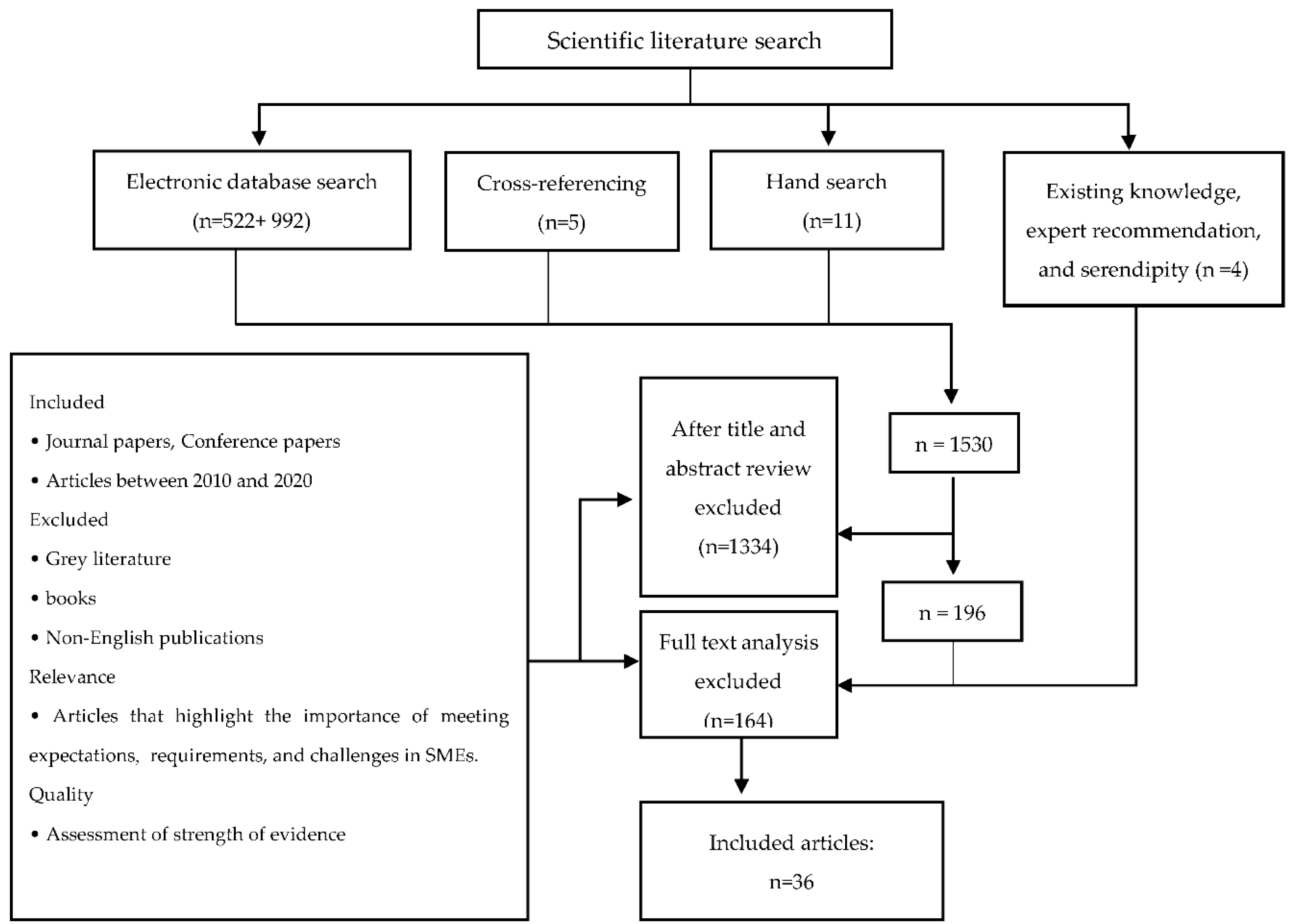
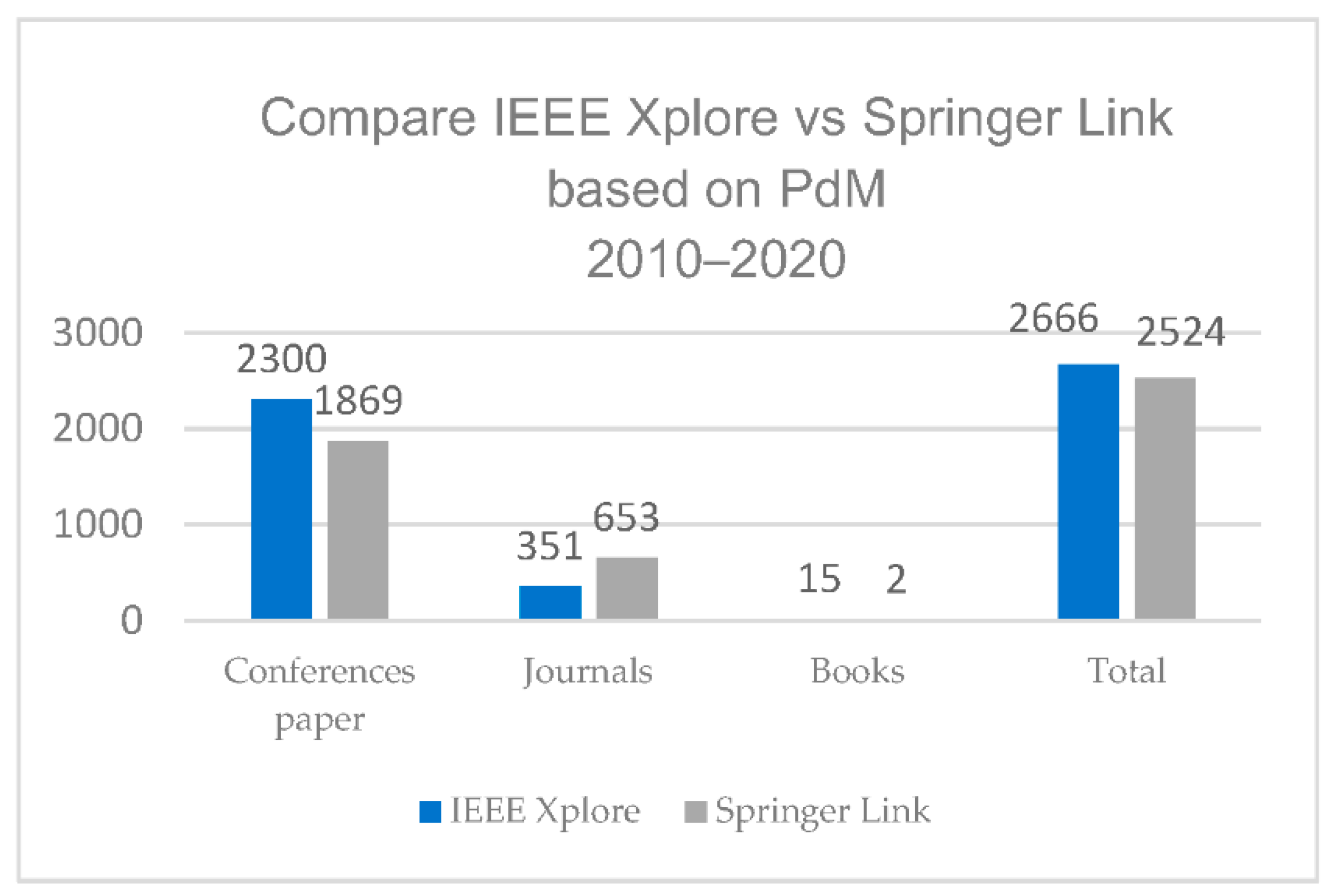
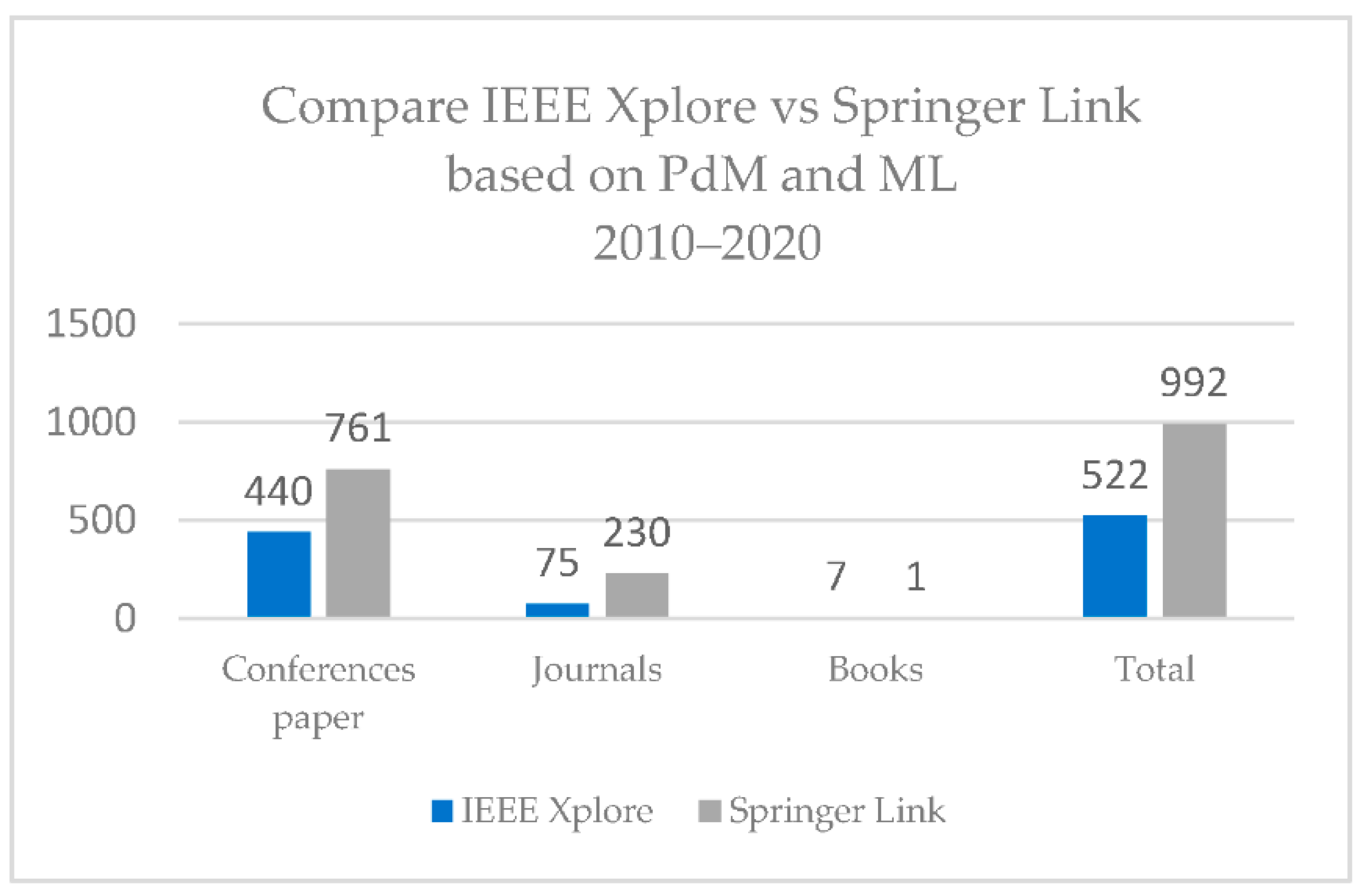
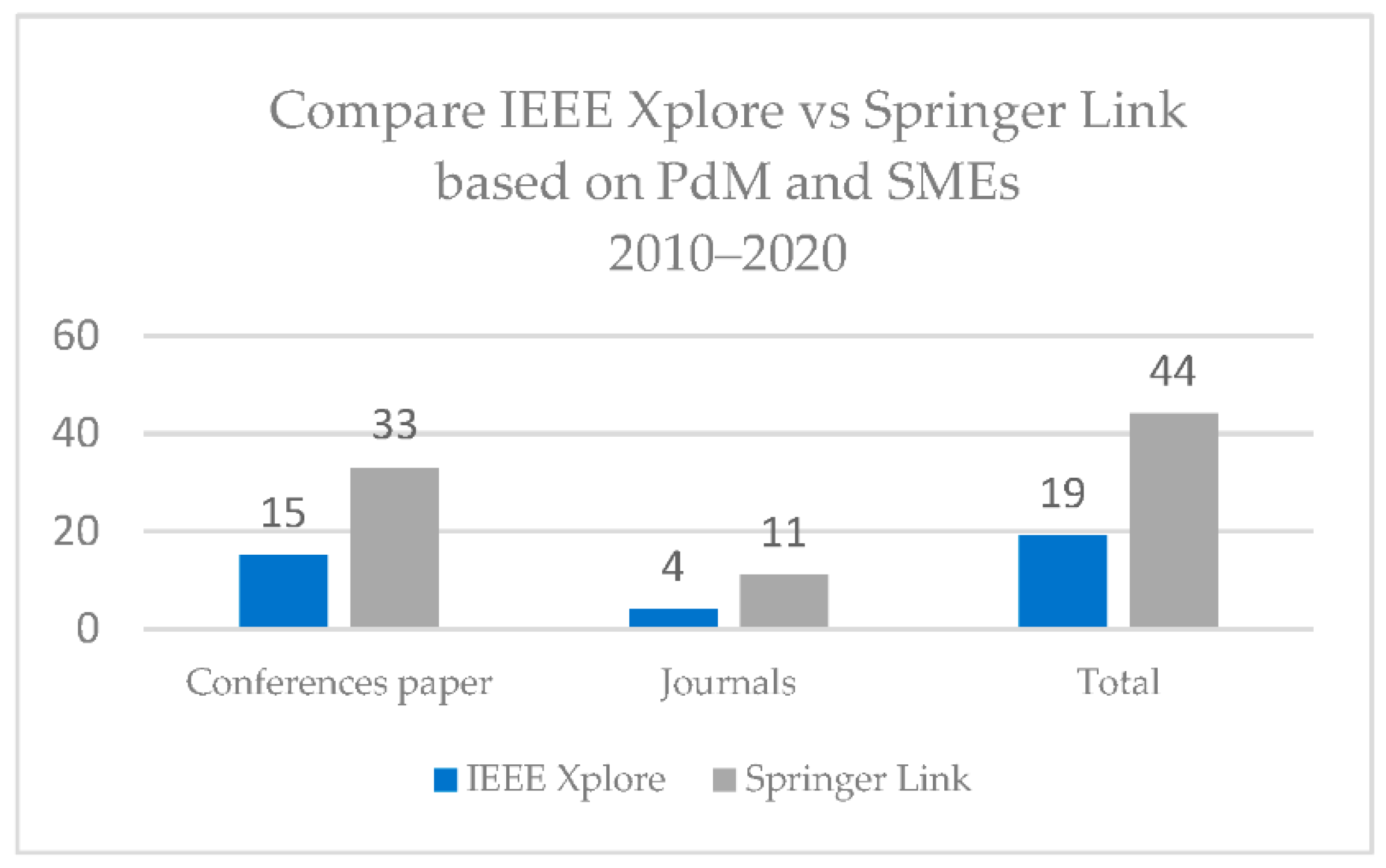

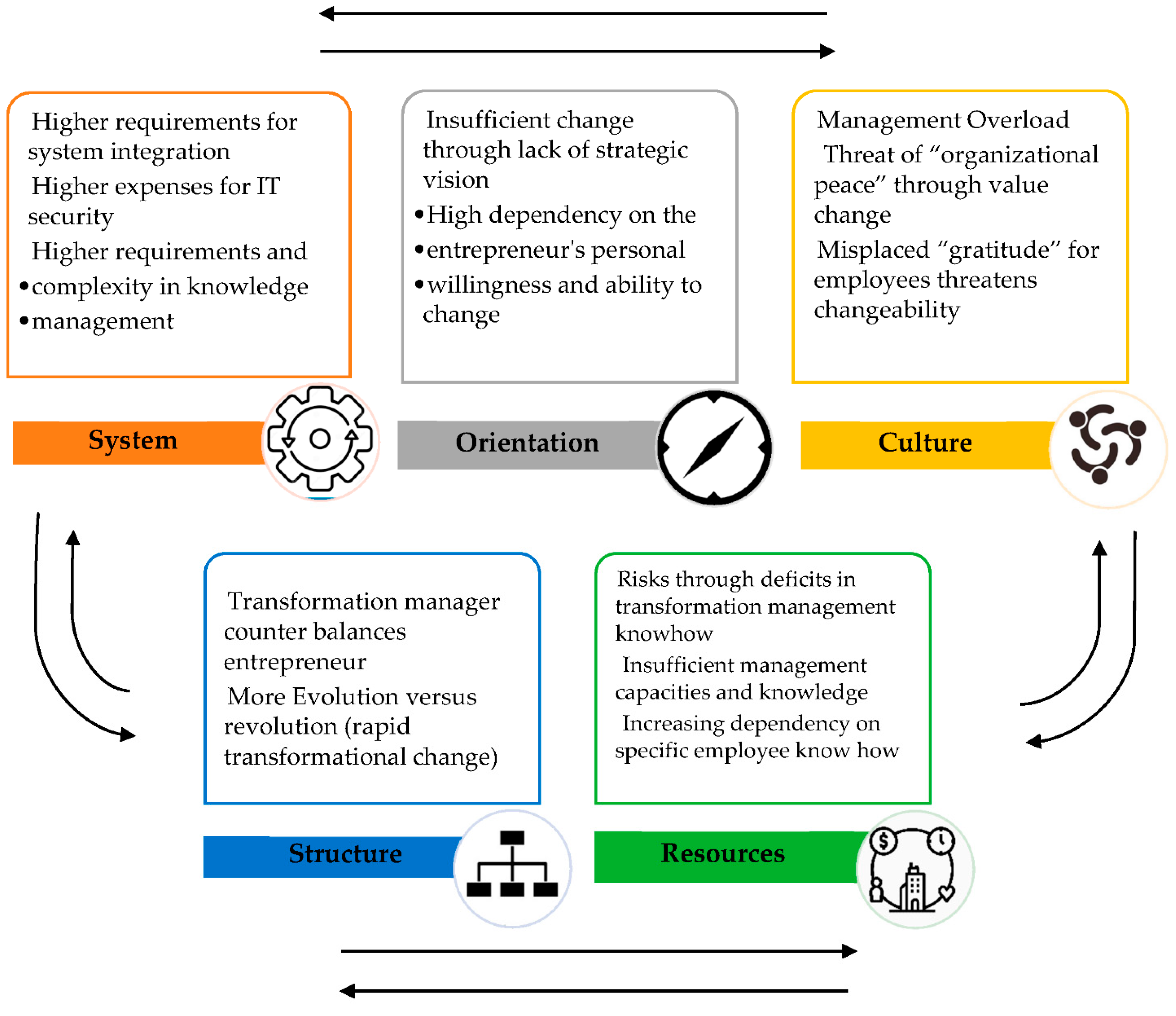

| Categories | Data Source | Search String | Specific Filter |
|---|---|---|---|
| Group A | IEEE | All Metadata: “Predictive Maintenance” in command search tab (under advanced search) | Date between 2010 and 2020 |
| Springer Link | |||
| Group B | IEEE | All Metadata: “Predictive Maintenance” AND (“Machine Learning”) in command search tab (under advanced search) | |
| Springer Link | |||
| Group C | IEEE | All Metadata: Predictive Maintenance AND All Metadata: small enterprisesORAll Metadata: Predictive Maintenance AND All Metadata: SMEsORAll Metadata: Predictive Maintenance AND All Metadata: small companies | |
| Springer Link | ‘“Predictive Maintenance” AND (“small enterprises” OR “SMEs” OR “small companies”)’ in command search tab (under advanced search) |
| Data Source | Group A | Group B | Group C |
|---|---|---|---|
| IEEE | 2666 | 522 | 20 |
| Springer Link | 2524 | 992 | 176 |
| Actors | Interactions between the entities and stakeholders |
| Adopt a philosophy in an integrated organization | |
| Adopt a strategy in an integrated organization | |
| Budget reclassification between units | |
| Information | Acquire the required qualifications |
| Value Proposition | Requires a systematic process for service innovation by digital technology |
| Implement a culture of failure in the organization |
| Solutions | Expectation | Requirement | Challenge |
|---|---|---|---|
| Deep belief network (DBN) method to predict backlash error [17] | 🗶 | ||
| Predictive virtual enterprise maintenance processes [18] | 🗶 | ||
| Proposed single-board computer (the Raspberry Pi 3 Model B) and IIOT device (the Sense HAT) [20] | 🗶 | ||
| User-friendly interface and integrated platform (FGS2I4.0) [24] | 🗶 | 🗶 | |
| A proposed toolkit for the implementation of Industry 4.0 [9] | 🗶 | ||
| Suggestion of the axiomatic design for the implementation of a specific solution for each enterprise [9] | 🗶 | ||
| Cloud computing and IOT solutions [22] | 🗶 | 🗶 | |
| Logistic regression and random forest (RF) for the design of predictive models in the Industry 4.0 environment [38] | 🗶 | 🗶 | |
| Support of the top management, external knowledge, and the usage of benchmarks [21] | 🗶 | 🗶 | |
| Wireless technologies and mobile systems [25] | 🗶 | 🗶 | 🗶 |
| Combination prediction method of power transformers based on the grey model [26] | 🗶 | 🗶 | 🗶 |
| Instant email notification system for every maintenance schedule generated [27] | 🗶 | ||
| Human-level concept learning and hierarchical probabilistic learning [35] | 🗶 | ||
| Titan software platform for integrating production environments withIndustrial DevOp [45] | 🗶 | ||
| Localization of knowledge [37] | 🗶 |
Publisher’s Note: MDPI stays neutral with regard to jurisdictional claims in published maps and institutional affiliations. |
© 2021 by the authors. Licensee MDPI, Basel, Switzerland. This article is an open access article distributed under the terms and conditions of the Creative Commons Attribution (CC BY) license (https://creativecommons.org/licenses/by/4.0/).
Share and Cite
Hassankhani Dolatabadi, S.; Budinska, I. Systematic Literature Review Predictive Maintenance Solutions for SMEs from the Last Decade. Machines 2021, 9, 191. https://doi.org/10.3390/machines9090191
Hassankhani Dolatabadi S, Budinska I. Systematic Literature Review Predictive Maintenance Solutions for SMEs from the Last Decade. Machines. 2021; 9(9):191. https://doi.org/10.3390/machines9090191
Chicago/Turabian StyleHassankhani Dolatabadi, Sepideh, and Ivana Budinska. 2021. "Systematic Literature Review Predictive Maintenance Solutions for SMEs from the Last Decade" Machines 9, no. 9: 191. https://doi.org/10.3390/machines9090191






